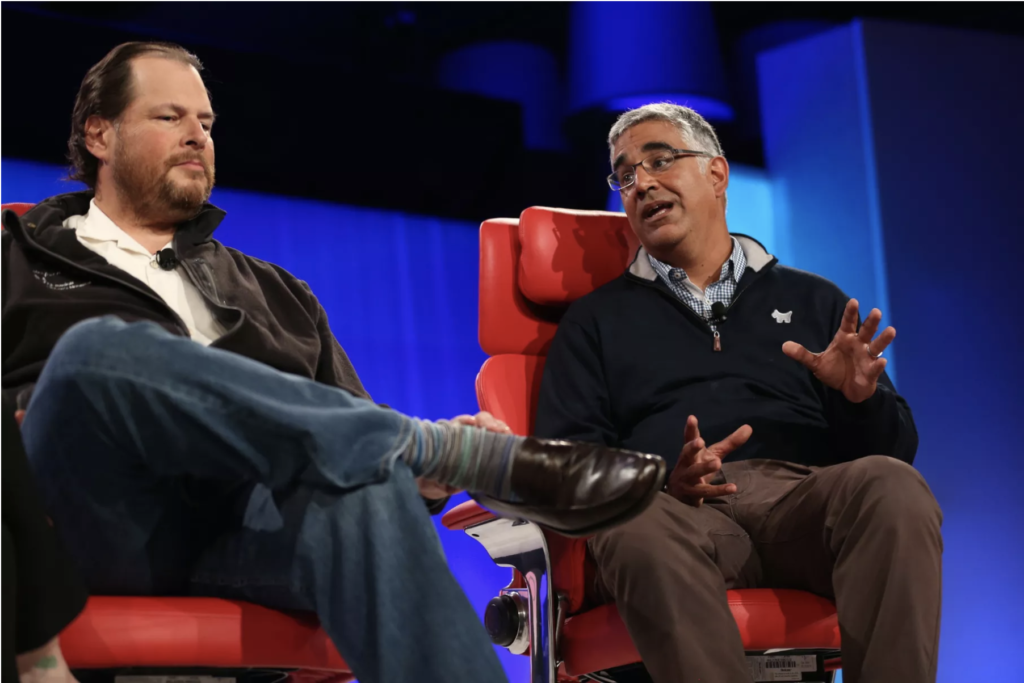Workday is reinforcing the battles lines in the Cloud Wars as it tightens its long-standing alliances with Microsoft and Salesforce, highlights the shortcomings of on-premises apps during COVID-19 and exceeds $1 billion in quarterly revenue for the first time.
The upshot is that Workday’s becoming even more of a power player in the Cloud Wars. Under CEO Aneel Bhusri, the company is looking to not only provide more and better combinations of solutions for its customers but also increasingly isolate Oracle and SAP as “legacy” players whose massive installed bases of on-premises applications are woefully out of date.
From yesterday’s fiscal 2021 first-quarter earnings call, here’s a collection of the most-important comments from Bhusri and his executive team on customers, competitors, partners and prospects.
1. The fluid power of cloud applications.
“We’ve also heard from countless customers who, like us, are using Workday to seamlessly close their books 100% remotely for the first time ever,” Bhusri said. “We have healthcare customers that are relying on Workday to redeploy critical people resources with great agility and we have heard from our planning customers who are using our solution to dynamically adjust their financial workforce plans. In fact, in late March we saw more than 30x increase in the number of scenario models that our customers were running…
“One of the many benefits of the cloud is that we can deploy our customers 100% virtually. And we showcased that strength in Q1 with more than 90 customer go-lives in March and April alone. Quite notably, two of these customers have more than 85,000 employees each: Jardine Matheson in APJ and John Lewis Partnership in EMEA.”
2. Tighter collaboration with longtime BFF Salesforce.
“Workday and Salesforce have been great partners for a long time and now have countless joint customers,” Bhusri said. “When the pandemic hit, many had to flip to a completely remote workforce overnight, closing offices, schools, services and more and others had to turn on a 24/7 team in an instant. Our HCM customers are leveraging the power of the data in Workday as a source of truth to manage their workforces which has included things like identifying essential workers, deploying people with relevant skill sets and more.
“And at the same time, Salesforce has just announced Work.com, which is a powerful platform for organizations to reopen safely and manage their logistics and returning to work. So, it only made sense to bring Workday and Work.com together in a way that will simplify things for our customers immensely, eliminating the need for reconciliation between various systems and more as they prepare their workforce and return to work safely and securely, and this is just a start.”
Did you catch that “this is just a start” line?
3. Continued strong growth in Financials.
“I’m pleased to say that we now have over 900 customers that have selected us as their core financial system. We saw continued momentum in Q1, including a Financials-first win at a Fortune 50 company, Fannie Mae,” Bhusri said. “We also saw solid demand for our expanding suite of products that support the office of the CFO and the Chief Procurement Officer.”
4. Microsoft alliance centers around Planning.
“On the planning front, we expanded our partnership with Microsoft. So Workday customers can run Workday Adaptive Planning on Microsoft Azure Cloud,” Bhusri said. “And Microsoft became the first Workday customer on Azure as they adopt Workday Adaptive Planning to help them with their planning, budgeting and forecasting.”
5. Deal sizes are surging.
Co-president Chano Fernandez noted that for the second quarter in a row, the metric of “annual contract value” (ACV) for new deals topped 50%.
“Momentum with our ‘Back to Basics’ team continued in Q1 with 50%-plus new ACV growth performance spanned across customer segments and products, including core Financials, Adaptive Planning, Learning and Prism Analytics,” Fernandez said. “The mix of new ACV coming from installed customers has been on the rise for us over the last few quarters. We continue to add resources to better target the growing installed base opportunity and we expect to continue to lean into this effort in the quarters and years ahead.”
6. Customer engagements improved markedly in May over April.
“It’s also important to note we have seen improved prospect engagements since April,” Fernandez said. “We have also seen healthy pipeline growth for FY’22 as opportunity shift from first half to both Q4 and into FY’22… We are in a competitive market but we feel very confident in our positioning and saw no meaningful changes to competitive dynamics in Q1. In addition, our discounting was in line with historical levels as most customers’ negotiations centered around more flexible payment terms to help ease the initial upfront cash burden.”
Fernandez later added this: “But there has been a significant uptake in engagement and positive sentiment relative to, I would say, four weeks ago. So, much of our activity, as I said, is now focusing a set of industries where we’re seeing the greatest near-term demand but we also continue dialogue in verticals that are more impacted by COVID to ensure that we’re well positioned as we emerge from this environment.”
7. The COVID-19 pandemic has exposed the weaknesses of on-premises technology in an increasingly digital world.
“I cannot tell you how many prospects I have spoken with over the last few months who have told me this environment has highlighted how ill-prepared their legacy ERP systems are for rapid change,” Fernandez said. “And I have heard from many customers currently implementing who are experiencing a faster and more-productive project on a fully remote basis.”
8. “Lots of CIOs who said, ‘I wish I had everything in the cloud right now.’”
“On the finance side, I think this crisis will be a catalyst for people switching from on-premise into the cloud for finance. And we are already seeing that the growth rates are at healthy levels,” Bhusri said. “But I’ve talked to lots of CIOs who said, ‘I wish I had everything in the cloud right now. I’m struggling with my on-premise both because of the labor required and people required to be on-site and because of systems that are really not very agile or flexible…’
“HR is going to continue to be healthy. I think what we’re going to see is a growing emphasis on the area of skills, learning, talent. All the areas where, we’re going to have over 30 million people unemployed, we’ve got to get these folks back to work and we’ve got to get them the right skills. And I think a lot of companies are going to be working probably alongside some of the states and local governments to figure out how to get these folks back to work. And that will be right in our sweet spot.”
9. The power of Planning in the cloud.
“In this environment, both Planning and Scout RFP have been very strong solutions,” Bhusri said. “People are really struggling with the legacy planning tools. And, I mean, I even look at our company and how many plans we generated in the last couple months because no one knows how this is all going to shake out. But with Scout RFP, it’s a quick implementation, you can get in control of your spend in a very global and unified way, and that’s another thing that’s been doing well.”
Vice Chairman Tom Bogan added this: “We’ve seen a real uptick in interest in planning. Companies are running, as you would expect, significantly more scenarios… I think the importance of planning, and particularly cloud-based planning solutions, where the whole team can be connected holistically, has resonated with customers. We’ve seen tremendous interest in Workforce Planning. Everybody is thinking through what the next-generation workforce looks like.”
10. Regarding Microsoft: “We’d like to do more with them.”
“We’ve had a great partnership with Microsoft for a long time, really around Office 365 and where we play around Teams. And this just builds on that,” Bhusri said. “Adding Azure into the mix right now just for Adaptive, but that’s — it’s also the first time that Microsoft has become a Workday customer, although LinkedIn has been a Workday customer for quite some time. So it’s just the natural progression of a partnership. I think Microsoft is a great company, Satya is a great CEO, and we’d like to do more with them.”
Got that? Bhusri “would like to do more” with Microsoft, and the hook-up with Salesforce and Work.com “is just a start.”
Sounds to me like the alliances in the Cloud Wars are becoming more intense and more strategic than ever before.
RECOMMENDED READING
Will Workday Whack Oracle and SAP Again on Earnings Call?
Microsoft Top 10 Customers for Digital Transformation: the Satya Nadella Touch
Bill McDermott Unplugged: ServiceNow CEO Riffs on Oracle & SAP, Culture, Grateful Dead
Microsoft Flexes Trillion-Dollar Muscles: Competitors Sweat, Customers Swoon
How Goldman Sachs Is Becoming a Technology Company
Larry Ellison Picks Amazon’s Pocket—Again—as Cloud Momentum Builds
Disclosure: at the time of this writing, Workday was among the many clients of Cloud Wars Media LLC and/or Evans Strategic Communications LLC.
Subscribe to the Cloud Wars Newsletter for in-depth analysis of the major cloud vendors from the perspective of business customers. It’s free, it’s exclusive and it’s great!








